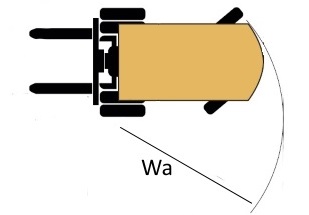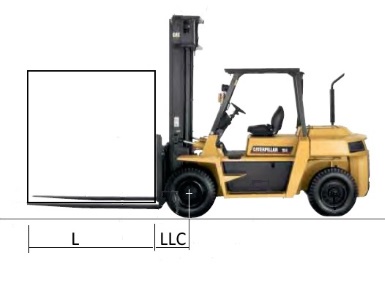Complete Powerpoint slide presentation for forklift instructors. Ready made training course
Making sure the forklift truck will fit the aisleways
 If you have aisleways you need to make sure the forklift truck can fit in them! I have seen many an application over the years where the aisleways were too small for the forklift truck in use. When this happens, the forklift operator has no choice but to turn with the load elevated or with the mast on rear tilt or both. Either of these things can cause a forklift truck to overturn and even if it doesn't, production will be slowed down.
If you have aisleways you need to make sure the forklift truck can fit in them! I have seen many an application over the years where the aisleways were too small for the forklift truck in use. When this happens, the forklift operator has no choice but to turn with the load elevated or with the mast on rear tilt or both. Either of these things can cause a forklift truck to overturn and even if it doesn't, production will be slowed down.
To obtain the correct aisleway dimension can be tricky as manufacturer's specification sheets don't always tell the truth. The official formula for working out the ninety degree stacking aisleway dimension, (known as Ast4 or Ast3), is shown as:
WA+LLC+L
where
WA = Forklift truck outer turning radius
LLC = forklift truck's lost load centre
L = Length of load
(The lost load centre is the horizontal distance from the centreline of the front axle to the front face of the forks)
Whilst this gives the theoretical minimum ninety degree stacking aisle dimension it does NOT take into account any room for real life operator clearance. If this dimension were to be used, safe forklift operation would be impossible in the aisleway concerned!
To overcome this problem forklift manufacturers tend to add on 100 mm, (4 ins), either side of the forklift for what they laughingly call "operator clearance"
The problem with this clearance dimension is that in reality it is not enough. The ABA forklift operator's test recommends that 300 mm, (12 ins), is added to the theoretical ninety degree stacking aisle dimension and even this can only be serviced by properly trained and experienced operators.

To recap, the minimum distance between racking uprights should be:
WA = Forklift truck outer turning radius plus
LLC = forklift truck's lost load centre plus
L = Length of load plus
30 cm, (12 ins)
Anything less than this will cause production slowdowns, damage to racking and in extreme cases, possible forklift overturn!
Reach trucks are worked out in a similar fashion to that shown above but there are some differences. Click here for the formula for reach truck aisleway turning dimensions.